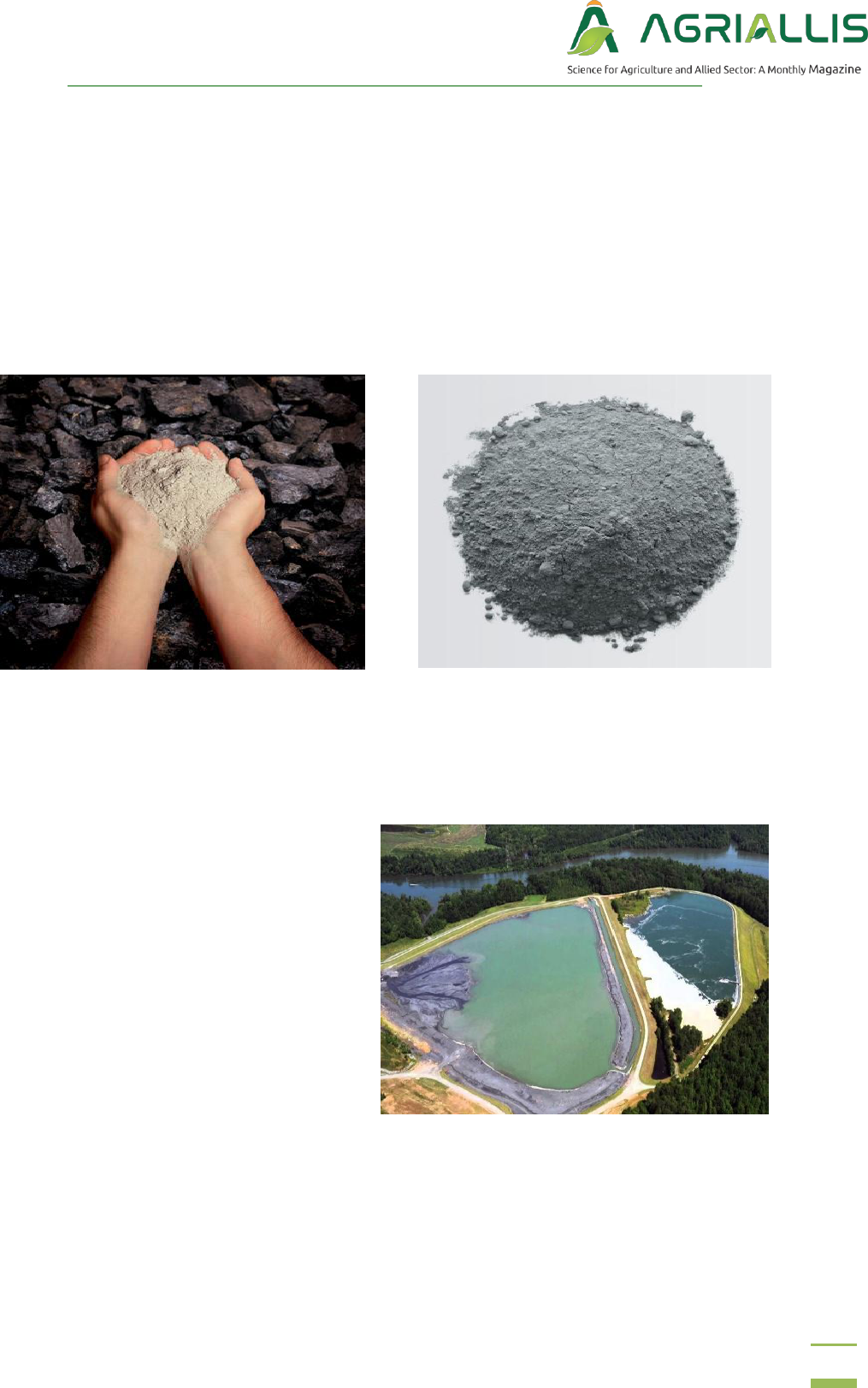
Volume 4, Issue 6
www.agriallis.com
9
ntensive cultivation leads to meet the food demand of present generation but
overexploitation of natural resources like soil and water bodies in relation to their
capabilities results in decreasing level of organic matter and soil health. Sustainability is
necessary to meet the demand of present generation as well as keep the soil fertile and
healthy for future generations without deteriorate its quality. Scientific management, timely
and safe disposal of fly ash is a unsolved problem. At present time, there is a need of safe and
profitable disposal of fly ash is needed. Fly ash contains various essential plant nutrients. Fly
ash is a cheaper and easily available source of plant nutrients. Utilization of fly ash in
agriculture will be a milestone in timely disposal of fly ash with reduction in cost of
cultivation. Fly ash improves the soil health which results in higher crop yield. Fly ash is a
cheaper and easily available source of plant nutrients as compared to costly chemical
fertilizers, which reduce dependency on chemical fertilizers as well as reduce the cost of
cultivation.
In the last decades, rising population of our country enforced on traditional sources of
energy to produce more outcome to fulfil the demands of present generation. With the time,
various alternate source of energy production come into limelight like solar energy, wind,
turbine, thermal plant, nuclear power generation plants. Even with discovery of such type of
energy sources, the hyperbolic use of coal cannot be counterbalanced in various developing
countries like India. In India, per year about 175 million tonnes of fly ash is produced from
various thermal power generation plants and it is expected to production of 300 million
tonnes fly ash in near future (Pani et al., 2015). Every year, during the combustion of coal in
thermal power plants, Bricks kilns and other industries, various by products produced.
I
Article Id
AL04134
ROLE OF FLY ASH IN AGRICULTURE: A SCIENTIFIC WAY
TO IMPROVE SOIL HEALTH
Email
1
Pawan Kumar*,
2
Anirudh Choudhary
and
1
Santosh Yadav
1
Department of Soil Science and Agricultural Chemistry, Rajasthan
College of Agriculture, MPUAT, Udaipur (Raj.)-313001, India.
2
Department of Soil Science and Agricultural Chemistry, College of
Agriculture, Sumerpur (Pali), Agricultural University, Jodhpur, (Raj.)-
306902, India
pawanparihar380@gmail.
com

Volume 4, Issue 6
www.agriallis.com
10
Among these, fly ash is a major important by product, which management and safe disposal
is an unsolved problem. The generation of electricity leads to anthropogenic emission of CO
2
,
SO
2
, NO
x
along with fly ash in huge quantity by thermal power plants (Singh and Pandey,
2013). Every year more than 100 million tonnes of fly ash is produced in more than 1800
thermal power plants and bricks kilns units. Presently the utilization of fly ash on global basis
is about only 25% of total fly ash produced, remaining is landfilled and surface impounded
(Leaet al., 2021).
Disposal of Fly Ash
In general fly ash is disposed either
by dry or wet method. In dry method, fly
ash is disposed through dumped it in
landfills and dry basins, While in wet
method, fly ash is washed out in artificial
lagoons with the help of water, which
commonly called Pond Ash. Both these
method of disposal of fly ash is costly and
harmful to human health along with lead to
soil quality and health degradation. Landfilling of fly ash adversely affect the soil fertility and
pollute the quality of ground water also.
Fig 1: Coal-based fly ash
Fig 2: Fly ash pond

Volume 4, Issue 6
www.agriallis.com
11
Effect of Fly Ash on Soil Properties
1. Soil Texture
The application of fly ash to heavy black clay soils can be alter their texture and make them
more friable to easily plough them and favour to enhance germination of crop seeds and
minimize soil crusting. An application of fly ash improve the soil texture (Panda and Biswal
2018).
2. Soil Structure
With the application of appropriate quantity of fly ash can be make soil crumby and granular
with improve soil structure, which favour crop growth and yield. Fly ash improves the soil
structure, when applied to soils (Dhindsa et al., 2016).
3. Bulk Density
Fly ash reduce the bulk density of soil, when applied to the soils. The impact of fly ash on
soil physical properties on several soils mixed with 50% fly ash reveals that reduction in bulk
density of soil. The particle of fly ash is very similar to silt, which alter the bulk density of
soil, when applied to soils (Panda and Biswal, 2018).
4. Porosity (%)
Anaddition of fly ash to sandy soils alters the soil texture permanently with increased micro
porosity and improved water holding capacity of such soils (Michel et al.,2004).
5. Electrical Conductivity
Anapplication of fly as 10, 20, 30 and 40% (w/w basis) in clay, sandy clay loam, sandy and
sandy loam resulted in increased electrical conductivity (Panda and Biswal, 2018).
6. Infiltration Rate
Fly ash improve soil physical properties like soil texture, soil structure, aeration
status.Moderate infiltration rate favour a great enhance soil aggregation and minimize runoff
losses and protect the soil from erosion. So, fly ash can be used for enhanced water
infiltration rate.

Volume 4, Issue 6
www.agriallis.com
12
7. Soil Organic Matter
Fly ash is a good source of organic matter, when applied to soil, it has been enhancing the
level of soil organic matter. Soil organic matter is a good source or store house of plant
available nutrients. Soil organic matter hold the plant nutrients by chelate formation and
minimize their leaching losses.
8. Water Holding Capacity
The application of appropriate quantity of fly ash improves the levels of water holding
capacity of a soil(Dhindsa et al., 2016). Several field experiments reveals that soils mixed
with 50% fly ash showed a higher water holding capacity as compared to other soil. An
application of fly as 10, 20, 30 and 40% (w/w basis) in clay, sandy clay loam, sandy and
sandy loam resulted in increased water holding capacity (Panda and Biswal, 2018).
9. Soil pH
Fly ash can be used to correct both the soil acidity and soil alkalinity. Fly ash can be acidic or
alkaline which is depends upon the source and combustion process.The application of fly as
10, 20, 30 and 40 % (w/w basis) in clay, sandy clay loam, sandy and sandy loam resulted in
increased soil pH (Panda and Biswal, 2018). Fly ash when applied to acidic soils, act as a
liming material to neutralize soil acidity which enhance the available nutrient status of the
soil. The principal beneficial characteristics offly ash is due to carbonate and hydroxide salt
present in it.
10. Cation Exchange Capacity
Fly ash contains various cations and anions, when fly ash is applied to soil, these cations and
anions replace otherion on exchangeable sites and enhanced cation exchange capacity which
favours certain plant nutrients availability. An application of fly ash increase the level of
cation exchange capacity of soil (Tomar et al., 2015).
11. Soil Fertility level
Fly ash is also a rich source of various micronutrients including Fe, Mn, Zn, Cu, Boron and
Molybdenum (Meena et al., 2019). Higher concentration of essential plant nutrients including
K, Ca, Mg, Na, Zn and Fe in fly ash increased the yield of agricultural crops.An application
of fly ash with municipal biosolids prove N and P to the soil with leading to better crop

Volume 4, Issue 6
www.agriallis.com
13
production (Sahoo et al., 2021).So, fly ash can be used as a source of nutrient. An application
of fly ash with municipal bio-solids prove N and P to the soil with leading the better crop
production (Sahoo et al., 2021).
12. Microbial population and enzymatic activities
Fly ash is when applied to acidic soils, it corrects the soil acidity by rise the soil pH which
create a favourable environment for bacterial and other certain microbial population resulted
in nutrient transformation and nitrogen fixation. The soil applications of fly ash increase
activity of invertase, amylase, dehydrogenase and protease enzyme in soil system (Sarangi et
al., 2001). There was a significant effects on soil health in terms of microbial populations,
enzyme activities with improved bacterial community diversity (Leaet al., 2021).
13. Better Crop Yield
Fly ash contains essential plant nutrients in higher quantities. Higher concentration of
essential nutrients in fly ash including K, Ca, Mg, Na, Zn and Fe increased the yield of
agricultural crops. An application of fly ash with municipal bio-solids prove N and P to the
soil with leading to better crop production (Sahoo et al., 2021).
14. Act as Pesticide
Astudy reported that more than 50 species of insect pest of major agricultural crops found
susceptible to fly ash treatment. Fly ash can be used to control both chewing and sucking
pests of field crops like leaf folder, grasshopper, brown plant hopper, yellow caterpillar,
brown bug, red ear head bug, black bug. Soil application of 5% fly ash to tomato crop found
root knot nematode infestation.
Conclusion
Fly ash contains various essential plant nutrients in a wider range, which make it an
alternate source of plant nutrients and as a soil ameliorant to improve the soil quality and
health. Fly ash is a cheap and easily available source of plant nutrient. Fly ash application in
various soils has been showed an admirable positive effect on various physic-chemical and
biological properties as well as plant biomass and nutrient uptake by crop plants. Fly ash can
be used as ameliorant in both acidic and sodic soils depends upon nature of fly ash.
Applications of fly ash alone or combinations of with appropriate doses improve soil health
and subsequently crop yields.

Volume 4, Issue 6
www.agriallis.com
14
References
Dhindsa, H. S., Sharma, R. D. and Kumar, R. (2016). Role of fly ash in improving soil
physical properties and yield of wheat (Triticum aestivum L.). Agricultural Science
Digest-A Research Journal. 36(2): 97-101.
Lea, T. V., Ngoa, C. N. and Futamatab, H. (2021). Effect of fly ash amendment on sandy soil
properties and peanut yields. Science Asia, 47(3): 357-365.
Meena, R. K., Meena, R. and Ram, B. (2019). Effect of fly ash, phospho-gypsum and
chemical fertilizers on growth, yield and nutrient uptake of wheat (Triticum aestivum
L.) in Inceptisol. Journal of Pharmacognosy and Phytochemistry. 8(5): 733-736.
Michel C. Nolin, B. G. and Cambouris, A. N. (2004). Combined de-inking paper sludge and
poultry manure application on corn yield and soil nutrients. Canadian Journal of Soil
Science, 84(4): 503-512.
Panda, R. B. and Biswal, T. (2018). Impact of fly ash on soil properties and
productivity. International Journal of Agriculture, Environment and
Biotechnology, 11(2): 275-283.
Pani, N. K., Samal, P., Das, R. and Sahoo, S. (2015). Effect of fly ash on growth and yield of
sunflower (Helianthus annuus L.). International Journal of Agronomy and
Agricultural Research. 7(2): 64-74.
Sahoo, C. R., Sahu, R. K. and Padhy, R. N. (2021). Growth, yield and element-analysis of
rice (Oryza sativa L.), grown in soil amended with fly ash and municipal bio-
solids. Paddy and Water Environment. 19(1): 149-157.
Sarangi, P. K., Mahakur, D. and Mishra, P. C. (2001). Soil biochemical activity and growth
response of rice (Oryza sativa L.) in fly ash amended
soil. BioresourceTechnology, 76(3). 199-205.
Singh, J. S. and Pandey, V. C. (2013). Fly ash application in nutrient poor agriculture soils:
impact on methanotrophs population dynamics and paddy yields. Ecotoxicology and
Environmental Safety, 89: 43-51.
Tomar, D. and Khan, A. A. (2015). Physico-chemical properties of fly ash amended soils and
their impact on potato crop.5(2): 87-95.
